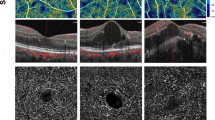Abstract
Purpose
To investigate the correlation between the features of optical coherence tomography (OCT) and the severity of concurrent retinopathy, central macular thickness (CMT), and best-corrected visual acuity in clinically significant diabetic macular edema.
Methods
In a prospective study, OCT was performed in 55 eyes of 55 patients with clinically significant diabetic macular edema, in 58 eyes of 30 patients with diabetes without retinopathy, and in 40 eyes of 21 healthy control subjects. The OCT features were categorized into: type 1, sponge-like retinal swelling; type 2, cystoid macular edema; type 3, serous retinal detachment; and type 4, vitreofoveal traction.
Results
The CMT in eyes with diabetic macular edema was significantly higher than in eyes of healthy controls or in eyes of diabetic patients without retinopathy (P < 0.001). Visual acuity correlated with CMT in diabetic macular edema (r = 0.558, P < 0.001). The prevalence of OCT type 1 was significantly higher in eyes with mild-to-moderate non-proliferative retinopathy (NPDR) than in eyes with severe NPDR to proliferative retinopathy (PDR) (P = 0.0069). The prevalence of OCT types 3 and 4 was significantly higher in eyes with severe NPDR to PDR than in eyes with mild-to-moderate NPDR (P = 0.0056). OCT type 1 showed the least CMT (P < 0.001) and the best visual acuity (P = 0.002).
Conclusions
There was a significant correlation between OCT patterns of clinically significant diabetic macular edema and severity of retinopathy, CMT, and visual acuity.



Similar content being viewed by others
References
Klein R, Klein BEK, Moss SE (1984) Visual impairment in diabetes. Ophthalmology 91:1–9
Klein R, Klein BEK, Moss Se, Davis MD, DeMets DL (1984) The Wisconsin Epidemiologic Study of Diabetic Retinopathy IV. Diabetic macular edema. Ophthalmology 91:1464–1474
Klein R, Klein BEK, Moss SE, Cruickshanks KJ (1995) The Wisconsin Epidemiologic Study of Diabetic Retinopathy XV. The long-term incidence of macular edema. Ophthalmology 103:7–16
Bresnick GH (1983) Diabetic maculopathy: a critical review highlighting diffuse macular edema. Ophthalmology 90:1301–1317
Kinyoun J, Barton F, Fisher M, Hubbard L, Aiello L, Ferris F III (1989) The ETDRS Research Group. Detection of diabetic macular edema: ophthalmoscopy versus photography—Early Treatment Diabetic Retinopathy Study report number 5. Ophthalmology 96:746–751
Nussenblatt RB, Kaufman SC, Palestine AG, Davis MD, Ferris FL III (1987) Macular thickening and visual acuity: measurement in patients with cystoid macular edema. Ophthalmology 94:1134–1139
Hee MR, Puliafito CA, Duker JS, Reichel E, Coker JG, Wilkins JR, et al (1998) Topography of diabetic macular edema with optical coherence tomography. Ophthalmology 105:360–370
Sánchez-Tocino H, Alvarez-Vidal A, Maldonado MJ, Moreno-Montañés J, Garcīa-Layana (2002) Retinal thickness study with optical coherence tomography in patients with diabetes. Invest Ophthalmol Vis Sci 43:1588–1594
Otani T, Kishi S, Maruyama Y (1999) Patterns of diabetic macular edema with optical coherence tomography. Am J Ophthalmol 127:688–693
Goebel W, Kretzchmar-Gross T (2002) Retinal thickness in diabetic retinopathy: a study using optical coherence tomography (OCT). Retina 22:759–767
Ozdek SC, Erdinc MA, Gurelik G, Aydin B, Bahceci U, Hasanreisoglu B (2005) Optical coherence tomographic assessment of diabetic macular edema: comparison with fluorescein angiographic and clinical findings. Ophthalmologica 219:86–92
Lattanzio R, Brancato R, Pierro L, Bandello F, Iaccher B, Fiore T, et al (2002) Macular thickness measured by optical coherence tomography (OCT) in diabetic patients. Eur J Ophthalmol 12:482–487
Yamamoto S, Yamamoto T, Hayashi M, Takeuchi S (2001) Morphological and functional analyses of diabetic macular edema by optical coherence tomography and multifocal electroretinograms. Graefes Arch Clin Exp Ophthalmol 239:96–101
Catier A, Tadayoni R, Paques M, Erginay A, Haouchine B, Gaudric A, et al (2005) Characterization of macular edema from various etiologies by optical coherence tomography. Am J Ophthalmol 140:200–206
Kang SW, Park CY, Ham D-I (2004) The correlation between fluorescein angiographic and optical coherence tomographic features in clinically significant diabetic macular edema. Am J Ophthalmol 137:313–322
Hussain A, Hussain N, Nuthetic R (2005) Comparison of mean macular thickness using optical coherence tomography and visual acuity in diabetic retinopathy. Clin Exp Ophthalmol 33:240–245
Ozdemir H, Karacorlu M, Karacorlu S (2005) Serous macular detachment in diabetic cystoid macular oedema. Acta Ophthalmol Scand 83:63–66
Browning DJ, McOwen MD, Bowen RM Jr, O’Marah TL (2004) Comparison of clinical diagnosis of diabetic macular edema with diagnosis by optical coherence tomography. Ophthalmology 111:712–715
Brown JC, Solomon SD, Bressler SB, Schachat AP, DiBernardo C, Bressler NM (2004) Detection of diabetic foveal edema: contact lens biomicroscopy compared with optical coherence tomography. Arch Ophthalmol 122:330–335
Early Treatment Diabetic Retinopathy Study Research Group (1985) Photocoagulation for diabetic macular edema. Early Treatment Diabetic Retinopathy Study report number 1. Arch Ophthalmol 103:1796–1806
Early Treatment Diabetic Retinopathy Study Research Group (1991) Early Treatment Diabetic Retinopathy Study design and baseline patient characteristics. ETDRS report number 7. Ophthalmology 98:741–756
Massin P, Duguid G, Erginay A, Haouchine B, Gaudric A (2003) Optical coherence tomography for evaluating diabetic macular edema before and after vitrectomy. Am J Ophthalmol 135:169–177
Fine BS, Brucker AJ (1981) Macular edema and cystoid macular edema. Am J Ophthalmol 92:466–481
Yanoff M, Fine BS, Brucker AJ, Eagle RC Jr (1984) Pathology of human cystoid macular edema. Surv Ophthalmol 28 [Suppl]:505–511
Acknowledgement
The authors thank Ms. Connie B. Unisa-Marfil for secretarial work.
Author information
Authors and Affiliations
Corresponding author
Rights and permissions
About this article
Cite this article
Alkuraya, H., Kangave, D. & Abu El-Asrar, A.M. The correlation between optical coherence tomographic features and severity of retinopathy, macular thickness and visual acuity in diabetic macular edema. Int Ophthalmol 26, 93–99 (2005). https://doi.org/10.1007/s10792-006-9007-8
Received:
Accepted:
Published:
Issue Date:
DOI: https://doi.org/10.1007/s10792-006-9007-8




